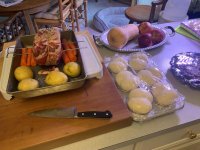Hey pharman,
Just caught this thread - dunno if you have decided yet on how to prepare your roast? I cooked this one for my little wife and her hard working technicians at CVS this evening. Nothing left but the rib meat that will be used for some French Dip sandwiches after Christmas.
Kinda late but I'll give you the method I picked up from my restaurateur father. Christmas season Prime Rib was the only time you could catch him in one of his kitchens. I've been cooking these for over twenty years now during the holidays.
Pre prep:
Make sure your oven temp is accurate and calibrate as necessary. Same with your meat thermometer and/or cooking probe.
Dress your rib heavily with coarse kosher salt then salt some more. Put it in the fridge covered with paper towels ideally one to two days beforehand but certainly overnight at the bare minimum.
Coarsely crack some peppercorns and mix an equal amount of coarse kosher salt for tomorrow.
Cooking day:
Pull your rib out of the fridge one to three hours before you want to start cooking. The heavier the rib - the more counter time. If you're cooking one 18lbs or more consider an extra half hour.
Dry the rib blotting with paper towels, cover with your salt peppercorn mix before moving into the oven. Place your temperature probe in the larger end of the rib. Depending on the size difference of the eye from end to end the probe could be anywhere between half to three quarters the length favoring the big end. Place the probe tip as accurately as you can estimate to the center of the eye.
Preheat your oven to 200 degrees on convection mode, and set your temp probe alarm to ninety degrees. When the internal rib temp reaches ninety, you can swap to non-convection roast mode if you choose as the surface will be perfectly desiccated. Or leave on convection if you're pressed for time. By now you will have an idea how quickly the internal temp is rising - adjust cooking mode accordingly. Reset your temp alarm to one hundred twenty to one hundred twenty-five based on your preference and what might be the disparity of size end to end on your rib.
When the alarm sounds, pull it out, tent with doubled foil, and depending on your timing and when you want to serve your meal it can set for up to an hour and a half with no issue. However, allow at
least thirty minutes for the juices to redistribute.
Jack your oven temp to five hundred degrees ten minutes before you want to carve. Place the rib uncovered in the hot oven for five minutes then pull. Wait five minutes then carve and serve.
If your oven thermometer and temp probe are accurate, your roast will look like this with no gray rings or overcooked edges - just pure delicious beef edge to edge. Except for those perfectly crispy caramelized "heels" your guests will fight over of course.


And the last pic that shows you did it right.

"Right" being the amount of juice on your carving board. This was a seven pounder and not a drop ran off the cutting board because the tasty juice is
IN the meat right where it should be. Hope some of this may be of help and good luck with your rib tomorrow.













